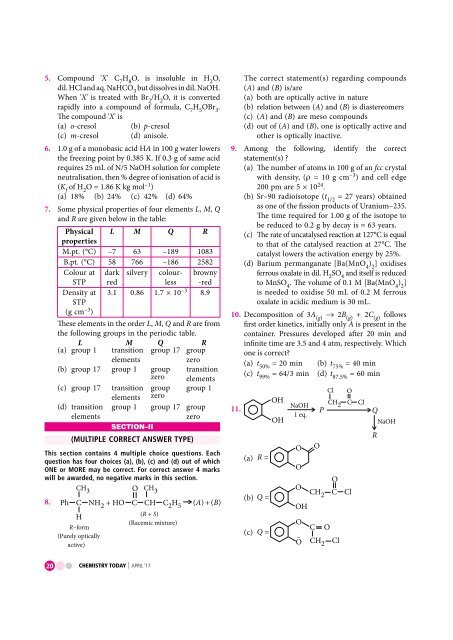Chemistry_Today_April_2017_vk_com_stopthepress
You also want an ePaper? Increase the reach of your titles
YUMPU automatically turns print PDFs into web optimized ePapers that Google loves.
5. Compound 'X' C 7<br />
H 8<br />
O, is insoluble in H 2<br />
O,<br />
dil. HCl and aq. NaHCO 3<br />
but dissolves in dil. NaOH.<br />
When 'X' is treated with Br 2<br />
/H 2<br />
O, it is converted<br />
rapidly into a <strong>com</strong>pound of formula, C 7<br />
H 5<br />
OBr 3<br />
.<br />
The <strong>com</strong>pound 'X' is<br />
(a) o-cresol (b) p-cresol<br />
(c) m-cresol (d) anisole.<br />
6. 1.0 g of a monobasic acid HA in 100 g water lowers<br />
the freezing point by 0.385 K. If 0.3 g of same acid<br />
requires 25 mL of N/5 NaOH solution for <strong>com</strong>plete<br />
neutralisation, then % degree of ionisation of acid is<br />
(K f<br />
of H 2<br />
O = 1.86 K kg mol –1 )<br />
(a) 18% (b) 24% (c) 42% (d) 64%<br />
7. Some physical properties of four elements L, M, Q<br />
and R are given below in the table:<br />
Physical L M Q R<br />
properties<br />
M.pt. (°C) –7 63 –189 1083<br />
B.pt. (°C) 58 766 –186 2582<br />
Colour at<br />
STP<br />
dark<br />
red<br />
silvery colourless<br />
browny<br />
-red<br />
Density at 3.1 0.86 1.7 × 10 –3 8.9<br />
STP<br />
(g cm –3 )<br />
These elements in the order L, M, Q and R are from<br />
the following groups in the periodic table.<br />
L<br />
(a) group 1<br />
M<br />
transition<br />
Q<br />
group 17<br />
R<br />
group<br />
elements<br />
zero<br />
(b) group 17 group 1 group transition<br />
zero elements<br />
(c) group 17 transition group group 1<br />
elements zero<br />
(d) transition<br />
elements<br />
group 1 group 17 group<br />
zero<br />
SECTION–II<br />
(MULTIPLE CORRECT ANSWER TYPE)<br />
This section contains 4 multiple choice questions. Each<br />
question has four choices (a), (b), (c) and (d) out of which<br />
ONE or MORE may be correct. For correct answer 4 marks<br />
will be awarded, no negative marks in this section.<br />
CH 3 O CH 3<br />
8. Ph C NH 2+ HO C CH CH 2 5 ( ) +( )<br />
( R + )<br />
H<br />
(Racemic mixture)<br />
R–form<br />
(Purely optically<br />
active)<br />
The correct statement(s) regarding <strong>com</strong>pounds<br />
(A) and (B) is/are<br />
(a) both are optically active in nature<br />
(b) relation between (A) and (B) is diastereomers<br />
(c) (A) and (B) are meso <strong>com</strong>pounds<br />
(d) out of (A) and (B), one is optically active and<br />
other is optically inactive.<br />
9. Among the following, identify the correct<br />
statement(s) ?<br />
(a) The number of atoms in 100 g of an fcc crystal<br />
with density, (ρ = 10 g cm –3 ) and cell edge<br />
200 pm are 5 × 10 24 .<br />
(b) Sr–90 radioisotope (t 1/2<br />
= 27 years) obtained<br />
as one of the fission products of Uranium–235.<br />
The time required for 1.00 g of the isotope to<br />
be reduced to 0.2 g by decay is ≈ 63 years.<br />
(c) The rate of uncatalysed reaction at 127°C is equal<br />
to that of the catalysed reaction at 27°C. The<br />
catalyst lowers the activation energy by 25%.<br />
(d) Barium permanganate [Ba(MnO 4<br />
) 2<br />
] oxidises<br />
ferrous oxalate in dil. H 2<br />
SO 4<br />
and itself is reduced<br />
to MnSO 4<br />
. The volume of 0.1 M [Ba(MnO 4<br />
) 2<br />
]<br />
is needed to oxidise 50 mL of 0.2 M ferrous<br />
oxalate in acidic medium is 30 mL.<br />
10. De<strong>com</strong>position of 3A (g)<br />
→ 2B (g)<br />
+ 2C (g)<br />
follows<br />
first order kinetics, initially only A is present in the<br />
container. Pressures developed after 20 min and<br />
infinite time are 3.5 and 4 atm, respectively. Which<br />
one is correct?<br />
(a) t 50%<br />
= 20 min (b) t 75%<br />
= 40 min<br />
(c) t 99%<br />
= 64/3 min (d) t 87.5%<br />
= 60 min<br />
11.<br />
(a)<br />
R =<br />
(b) Q =<br />
(c)<br />
Q =<br />
OH<br />
OH<br />
NaOH<br />
1 eq.<br />
O<br />
O<br />
Cl O<br />
CH 2<br />
C Cl<br />
P<br />
O<br />
O<br />
O<br />
CH2<br />
C Cl<br />
OH<br />
O<br />
C O<br />
–<br />
O CH2<br />
Cl<br />
Q<br />
NaOH<br />
R<br />
20 CHEMISTRY TODAY | APRIL ‘17


